 |
 |
 |
| |
Switching to Fosamprenavir (FPV) Led to Similar Efficacy and Safety in HIV-1-infected Subjects on their First PI Regimen: a Prospective, Open-label, Multicenter, Randomized Trial (ESS100290)
|
| |
| |
Reported by Jules Levin
IAC Mexico City Aug 3-8, 2008
B Young1, E DeJesus2, A LaMarca3, P Salvato4, D Sutherland-Phillips5, L Yau5, L Patel5, P Wannamaker5
1Division of General Internal Medicine, University of Colorado, Denver, CO, USA; 2Orlando Immunology Center., Orlando, FL, USA; 3Therafirst Medical
Center, Fort Lauderdale, FL, USA; 4Diversified Medical Practices, Houston, TX, USA; 5GlaxoSmithKline, Research Triangle Park, NC, USA
AUTHOR DISCUSSION
Over 48 weeks, virologic response (HIV-1 RNA levels <400 and <50 copies/mL) was similar in subjects who switched to FPV at baseline and those who continued on their baseline PI regimen. Those subjects who switched from their baseline PI to FPV at Week 24 appeared to have higher virologic response rates by Week 48.
There were 19 subjects who met the protocol definition of virologic failure (BL FPV-switch arm 8 (4%); baseline-PI arm 11 (11%). Of these, eight subjects chose to remain in the study and re-suppressed to HIV-1 RNA <400 copies/mL (BL FPVswitch: 4; baseline-PI: 4).
The current study design involved a comparison between subjects who remained
on their baseline PI regimen to those who were switched to a new FPV regimen.
The proportion of subjects who had any AEs through Week 48 was slightly higher in the switch arms than in the baseline PI arm. Overall, diarrhea was the most
frequently reported AE and the only treatment-related grade 2-4 GI AE occurring in more than one subject per treatment arm.
AUTHOR CONCLUSIONS
Subjects who were switched to FPV from another PI regimen had favorable virologic, immunologic, and safety outcomes.
Low rates of virologic failure were observed for subjects in the BL FPV-switch (4%) baseline PI (11%) arms.
Similar tolerability was noted for subjects who switched to a FPV-based PI regimen compared to those who continued on their baseline PI regimen. Adverse events in the three PI arms were generally mild to moderate.
ABSTRACT
Background: Fosamprenavir (FPV) is an efficacious and well-tolerated protease inhibitor (PI); switching to FPV from another PI regimen may offer advantages in tolerability and virologic response.
Methods: Subjects on their first PI-regimen (HIV-1 RNA<400 copies/mL (c/mL) for ≥3 months) were randomized 1:1 to switch to FPV (± 200mgRTV) or continue their baseline (BL) PI-regimen (stable NRTI background). Subjects in the BL PI-regimen arm were allowed to switch to FPV (± 200mgRTV) at Week 24. Primary efficacy endpoint was proportion of subjects with HIV-1 RNA<400 c/mL at 24 weeks (TLOVR, 12% non-inferiority margin).
Results: Baseline characteristics include median age 43 years in all arms;
% males and African American subjects, respectively: FPV-switch (79%, 35%); BL-PI (78%, 34%); and Wk-24 FPV-switch (85%, 24%).
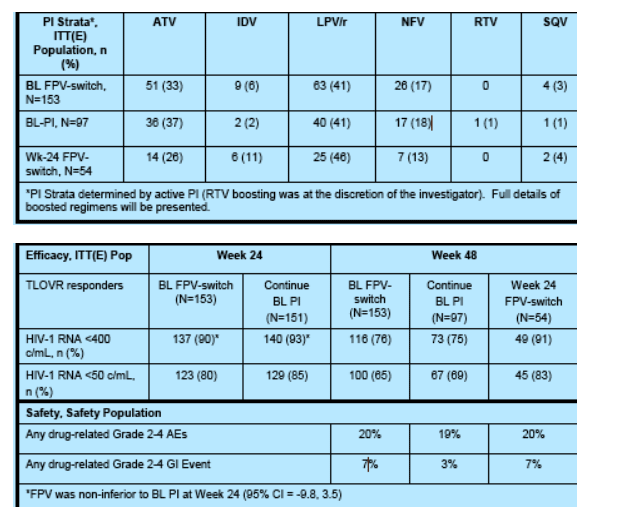
Low rates of virologic failure (confirmed ≥400c/mL) were observed through
Week 48 (BL FPV-switch, n=8, BL-PI, n=11; Wk-24 FPV-switch, n=0).
Conclusions: Virologic response was similar between the FPV switch and BL
PI arms at 24 and 48 weeks; subjects who switched to FPV at Week 24 appeared to have higher virologic response rates. Adverse events were similar between groups; however subjects who switched regimens reported more GI AEs.
INTRODUCTION
Current DHHS Guidelines recommend a number of different options for protease inhibitor (PI)-based combination antiretroviral therapy (ART), including fosamprenavir (FPV).1
Since there are several efficacious PIs available, tolerability becomes an important consideration in making treatment decisions.
We compared the safety, tolerability, and efficacy of switching subjects who were virologically stable on their current therapy of a protease inhibitor (PI) [± ritonavir (RTV)] + 2 nucleoside or nucleotide reverse transcriptase inhibitors (N[t]RTIs) to a fosamprenavir based therapy versus those who maintained their baseline (BL) PI therapy.
METHODS
ESS100290 was a Phase IIIb/IV, randomized, open-label, multicenter 48 week
study conducted in the United States with a planned 24 week interim analysis.
HIV-1 infected subjects with HIV-1 RNA <400copies/mL on their current PI regimen were randomized 1:1 to either switch their current PI for FPV (± 200mg RTV) for 48 weeks or to continue their current therapy for 24 weeks and then have the option of maintaining their current PI regimen or switching their PI regimen for FPV (± 200mg RTV) for an additional 24 weeks.
Subjects were stratified, based on their primary PI therapy into the following
groups at randomization Ð atazanavir (ATV or ATV/r), indinavir (IDV or IDV/r),
LPV/r, NFV, RTV and saquinavir (SQV hard-gel capsule with or without RTV
or SQV soft-gel capsule, with or without RTV).
Virologic failure (VF) was defined as two consecutive HIV-1 RNA measures
≥400 copies/mL at any time during the study.
Primary Efficacy Endpoint:
-- The proportion of subjects with HIV-1 RNA <400 copies/mL at Week 24
by the time to loss of virological response (TLOVR) algorithm.
Secondary Endpoints:
--Proportion of subjects with plasma HIV-1 RNA <400 copies/mL at
48 weeks
-- Proportion of subjects with plasma HIV-1 RNA <50 copies/mL at 24 and
48 weeks
-- Incidence of Grade (G) 2-4 adverse events (AEs) and gastrointestinal
(GI) AEs through Weeks 24 and 48
RESULTS
Overall, 304 subjects were randomized and included in the ITT(E) population.
Approximately 20% of the population was female and 33% was Black
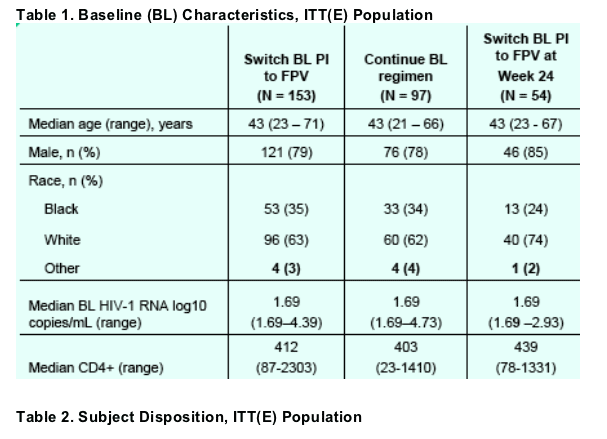
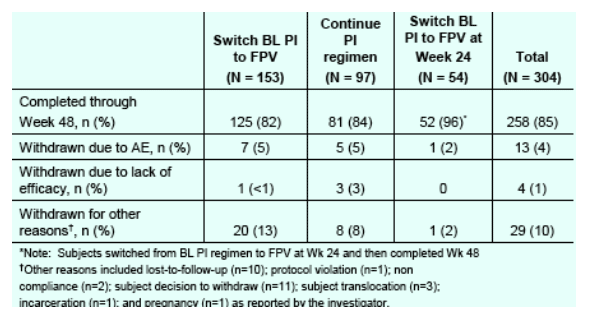
The most commonly used NRTIs during the study were zidovudine (ZDV)/lamivudine (3TC) and abacavir (ABC)/3TC in all three PI arms. Four subjects continued to use NNRTIs as their background therapy.
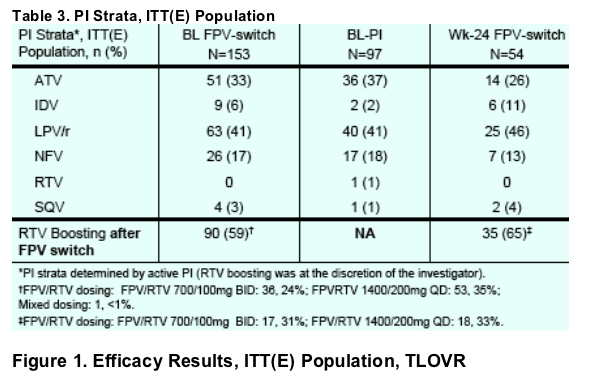
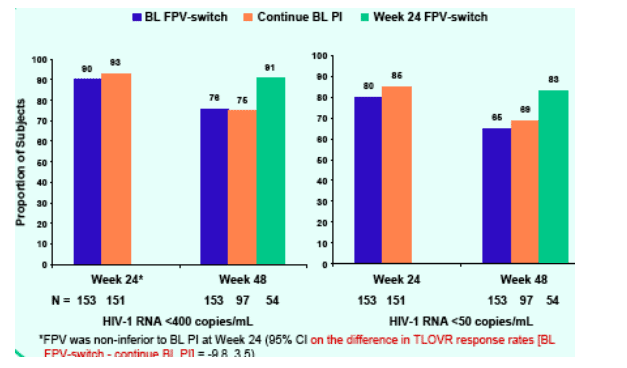
A total of 19 subjects met the protocol definition of virologic failure (confirmed
HIV-1 RNA ≥400 copies/mL); BL-FPV-switch: 8 (4%); baseline-PI arm: 11 (11%);
Wk-24 FPV-switch arm: 0.
Eight of these subjects chose to remain in the study and were able to achieve
virologic re-suppression and had HIV-1 RNA <400 copies/mL at last study visit
(Week 48 or beyond), including four subjects from the BL-FPV-switch and four
from the PI continue study arm.
At Week 48, the median change in CD4+ cell count was similar in the two
FPV-switch arms (BL-FPV-switch +54 cells/mm3, Wk 24 FPV-switch +64 cells/mm3) but lower in the baseline PI arm (+30 cells/mm3).
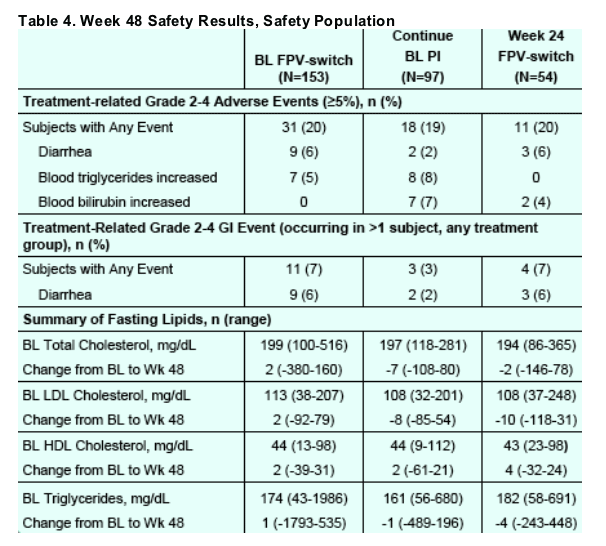
There were no deaths and only one treatment-related SAE (cerebrovascular
accident) in the baseline-PI group through Week 48. At the time of the event, the
subject had prolonged and untreated elevated cholesterol levels for approximately one year.
REFERENCES
1. Panel on Antiretroviral Guidelines for Adults and Adolescents. Guidelines for the use of antiretroviral agents in HIV-1 infected adults and adolescents. Department of Health and Human Services. January 29, 2008; 1-128. http://www.aidsinfo.nih.gov/ContentFiles/AdultandAdolescentGL.pdf
|
| |
|
 |
 |
|
|